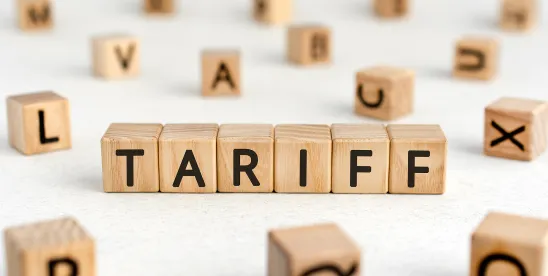Since early 2025, the Trump administration has imposed a series of broad sector- and country-specific tariffs. These measures were significantly expanded on April 2, 2025, with the announcement of a global tariff regime grounded in the principle of reciprocity. However, some of these new reciprocal tariffs were soon paused on April 9, 2025. Further, reciprocal tariffs on China were raised to an unprecedented 125%.
As global trade tensions continue to rise and many countries have already begun to introduce retaliatory tariffs on the U.S., it will be critical to monitor how increased duty rates will impact your company’s cross-border transaction activity, as well as to develop practical supply chain strategies to mitigate the impact of these fluid and dynamic trade disputes. Additional background on each of these tariff regimes is included below.
I. Targeted IEEPA Tariffs
Before proceeding to describe the reciprocal tariff regime which was announced on April 2, 2025 pursuant to the International Emergency Economic Powers Act (“IEEPA”), it is important to note that on April 9, 2025, the Trump administration announced that application of reciprocal tariffs announced on April 2, 2025 to apply respectively to 57 named countries, have been suspended from application for 90 days, except in the case of retaliating countries, including China. The global baseline tariff of 10% announced on April 2, 2025, however, has not been suspended and will be applicable. IEEPA tariffs announced in 2025 prior to April 2 are also not affected by this suspension, nor are Section 232 based sectoral tariffs.
On April 2, 2025 pursuant to the IEEPA, President Trump declared a national emergency arising from the foreign trade and economic practices of other countries and their impact upon the U.S. He proceeded to announce a new global tariff program, with heightened U.S. tariffs calculated by reference to the trade deficit maintained between the U.S. and individual foreign countries. This program introduces a global baseline tariff of 10% ad valorem on all imported goods, effective April 5, 2025, with higher, country-specific rates for 57 individual countries coming into effect on April 9, 2025 (see these specific rates in Table 1 below).
On the same day, the administration announced the elimination of the de minimis exemption for Chinese imports, which previously allowed duty-free entry for low-value shipments under $800. This change, effective May 2, 2025, aims to close loopholes exploited by e-commerce platforms to bypass tariffs.
Importantly, this new global tariff program does not replace or supersede the tariff increases announced previously by the Trump administration since the beginning of 2025, and adopted pursuant both to the IEEPA and to Section 232 of the Trade Expansion Act of 1962 (Section 232). The reciprocal tariff program announced on April 2, 2025 delineates tariff increases that will be added to the increases previously announced pursuant to the IEEPA. However, for imports of goods subject to Section 232 sectoral tariff increases, the reciprocal tariffs announced on April 2, 2025 will not be additively applied to increase the overall tariff rate for the imports.
Previously announced IEEPA based increases include a 25% tariff on imports of goods from Mexico and Canada, with exceptions including imports of goods that qualify for duty-free importation pursuant to the United States-Mexico-Canada Free Trade Agreement (USMCA). They also include a 20% tariff on imports of nearly all goods from China.
Additional IEEPA based increases include the so-called “secondary tariff” regime, announced on March 24, 2025, which imposed 25% tariffs on all goods from any country that has been determined to import Venezuelan oil, whether directly from Venezuela or indirectly through third parties, effective April 2, 2025.
II. Section 232 National Security Tariffs
Again, these tariffs adopted under the IEEPA apply separately to tariff increases adopted pursuant to Section 232. These include the following:
1. Steel and Aluminum
In February 2025, the Trump Administration announced updated 25% tariffs on steel and aluminum products pursuant to Section 232, targeting all countries. The updated Section 232 tariffs went into effect as of March 12, 2025 – and CBP has since published guidance on impacted HTS classifications for steel, aluminum, and related derivative products. On April 2, 2025 a tariff of 25% was added under this authority for imports of beer and empty aluminum cans.
2. Automobiles and Related Parts
On March 26, 2025, President Trump issued a new Section 232 proclamation imposing a 25% tariff effective April 3, 2025 on imported passenger vehicles (sedans, SUVs, crossovers, minivans, cargo vans) and light trucks, as well as key automobile parts (engines, transmissions, powertrain parts, and electrical components). On April 2, 2025 this proclamation was updated to include nearly 150 additional auto parts categories that will be subject to a 25% tariff beginning on May 3, 2025.
3. Pending Section 232 Investigations
On February 25, 2025 and March 1, 2025, the White House announced two new Section 232 investigations into (i) copper, and (ii) timber and lumber imports – which may result in additional tariff actions.
III. Noteworthy Impacts
China
On April 9, 2025, President Trump announced that, due to China’s application of retaliatory tariffs in response to the reciprocal tariffs he announced on April 2, 2025, the reciprocal tariff on almost all imports from China to the U.S. would be set at 125%. The previously announced IEEPA tariff of 20%, plus any base HTS tariff and/or Section 301 tariff previously announced, would be added to this minimum rate. However, imports of goods subject to Section 232 sectoral tariffs are exempt from the application of IEEPA tariffs. This means that imports of steel, aluminum, and automobiles from China subject to Section 232 tariffs, will only be subject to a 25% tariff in addition to any base HTS tariff.
Southeast Asia
A number of southeast Asian countries were also hit particularly hard by the specific reciprocal tariff regime. This includes Vietnam (46%), Cambodia (49%), and Thailand (37%). Since the increased tariffs implemented during President Trump’s first administration on China, many Chinese companies had set up manufacturing in these countries to avoid these tariffs. Increased tariffs on southeast Asian countries are likely a response to that circumvention. However, again, these country-specific reciprocal tariffs were suspended for 90 days on April 9, 2025. Thus, these countries will at least temporarily be subject to the 10% global baseline tariff. Imports from the countries subject to Section 232 sectoral tariffs are exempt from this IEEPA based global baseline tariff.
E.U.
Imports from the E.U. were not hit with tariffs as high as those on China and some southeast Asian countries. The E.U. was hit with a relatively smaller country-specific reciprocal tariff rate of 20% on April 2, 2025. This additional reciprocal tariff will be applied in addition to any base HTS tariff. However, any imports subject to Section 232 sectoral tariffs are exempt from this reciprocal tariff increase. Even though the E.U. has announced its intention to retaliate against applied U.S. tariffs, the temporary suspension for non-retaliating countries announced on April 9, 2025 has been confirmed to include the E.U. Thus, during this suspension the E.U. will be subject to the 10% global baseline tariff instead of the 20% country specific reciprocal tariff.
Canada/Mexico
Imports from Canada and Mexico were exempted from any new specific reciprocal IEEPA tariffs and are not subject to the global tariff of 10% announced on April 2, 2025. They are, however, still subject to the previously announced 25% IEEPA tariffs on both countries, with the important exception that imports qualifying for duty-free treatment under the USMCA will continue to enter the U.S. duty-free. Imports from both countries are also subject to any base HTS tariff and/or Section 301 tariff previously announced. Again, however, imports subject to Section 232 sectoral tariffs are exempted from the 25% IEEPA tariffs.
The Section 232 auto and auto parts tariffs are of particular significance to both countries, due to the close integration of the auto manufacturing supply chain among the USMCA members. Importers of Mexican and Canadian automobiles covered under the USMCA will be given the opportunity to certify their U.S. content, which will not be subject to tariffs. However, the Section 232 based 25% tariff applies to the non-U.S. content of the vehicle. Further, after May 3, 2025, auto parts covered by the USMCA will also be subject to a 25% tariff on the non-US content of these parts.
FTAs
Pursuant to the reciprocal tariff order, imports from countries with which the U.S. has free trade agreements (FTAs) are subject to the newly imposed reciprocal tariffs. This means that products previously benefiting from reduced or zero tariffs under FTAs will now incur the additional reciprocal tariffs as outlined in the order. Although again, this impact is subject to the suspension of country-specific reciprocal tariffs for non-retaliating countries announced on April 9.
IV. Supply Chain Strategies and Key Takeaways
Tariffs have been and will continue to be a focal point of the Trump Administration’s global trade policy, whether in pursuit of economic security, national security, or as a broader negotiation tactic. The tariff landscape is evolving rapidly and subject to constant evolution and change – and accordingly, companies and importers should take the following steps as soon as possible:
- Evaluate your supply chain and diversify suppliers to mitigate tariff costs;
- Reevaluate product designs and manufacturing operations to establish favorable country(ies) of origin;
- Negotiate tariff cost-sharing provisions in supply and distribution contracts to mitigate effect of increased tariffs;
- Explore options to utilize “first sale” pricing for the transaction value of imported goods, potentially leading to lower import duties;
- For related party transactions, reassess transfer pricing strategies and structuring of relationships for opportunities to mitigate the effect of tariffs;
- For outbound products, identify potential new costs to customers and distributors associated with retaliatory tariffs implemented by third-countries;
- Closely monitor evolving negotiations and regulatory changes for new exclusions, exemptions, or carve-outs that may impact your cross-border transaction activity;
- Utilize free trade agreements or free trade zones where practicable; and
- Consistently audit and document HTS classifications and country of origin determinations for imported goods to ensure customs compliance, timely duty payments, and efficient responses to requests for information issued by CBP.
Table 1
| Countries and Territories | Reciprocal Tariff, Adjusted |
| Algeria | 30% |
| Angola | 32% |
| Bangladesh | 37% |
| Bosnia and Herzegovina | 36% |
| Botswana | 38% |
| Brunei | 24% |
| Cambodia | 49% |
| Cameroon | 12% |
| Chad | 13% |
| China | 34% |
| Côte d`Ivoire | 21% |
| Democratic Republic of the Congo | 11% |
| Equatorial Guinea | 13% |
| European Union | 20% |
| Falkland Islands | 42% |
| Fiji | 32% |
| Guyana | 38% |
| India | 27% |
| Indonesia | 32% |
| Iraq | 39% |
| Israel | 17% |
| Japan | 24% |
| Jordan | 20% |
| Kazakhstan | 27% |
| Laos | 48% |
| Lesotho | 50% |
| Libya | 31% |
| Liechtenstein | 37% |
| Madagascar | 47% |
| Malawi | 18% |
| Malaysia | 24% |
| Mauritius | 40% |
| Moldova | 31% |
| Mozambique | 16% |
| Mozambique | 45% |
| Namibia | 21% |
| Nauru | 30% |
| Nicaragua | 19% |
| Nigeria | 14% |
| North Macedonia | 33% |
| Norway | 16% |
| Pakistan | 30% |
| Philippines | 18% |
| Serbia | 38% |
| South Africa | 31% |
| South Korea | 26% |
| Sri Lanka | 44% |
| Switzerland | 32% |
| Syria | 41% |
| Taiwan | 32% |
| Thailand | 37% |
| Tunisia | 28% |
| Vanuatu | 23% |
| Venezuela | 15% |
| Vietnam | 46% |
| Zambia | 17% |
| Zimbabwe | 18% |
Dan Joyner, Scott A. Jones, Angela Ennis, and John McCullough contributed to this article.









 />i
/>i

